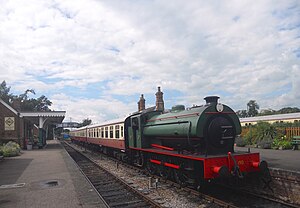Colne Valley Railway
| Colne Valley Railway | |
|---|---|

Castle Hedingham station on the Colne Valley Railway
|
|
| Coordinates | 51°59′48″N 0°34′47″E / 51.9966°N 0.5798°ECoordinates: 51°59′48″N 0°34′47″E / 51.9966°N 0.5798°E |
| Commercial operations | |
| Built by | Colne Valley and Halstead Railway |
| Original gauge | 4 ft 8 1⁄2 in (1,435 mm) standard gauge |
| Preserved operations | |
| Preserved gauge | 4 ft 8 1⁄2 in (1,435 mm) standard gauge |
| Commercial history | |
| Opened | 1861/1863 |
| Closed | 1961 Passenger traffic 1965 Freight traffic |
| Preservation history | |
| 1973 | land purchase |
| 1974 | Preservation Society formed |
| Headquarters | Castle Hedingham Station |
| Colne Valley and Halstead Railway | |
|---|---|
The Colne Valley Railway is a heritage railway based at Castle Hedingham Station, near Halstead in Essex, England. The railway consists of a 1 mile (1.6 km) long running line, with a fully reconstructed station, signal box and railway yard.
The railway occupies part of the former Colne Valley and Halstead Railway (CVHR), which opened in stages between 16 April 1860 and 10 May 1863. This part of the railway was a through line from Birdbrook to Wakes Colne.
The line closed on 1 January 1962, when all passenger and freight traffic between Haverhill and Yeldham ended. On 19 April 1965, all transiting freight traffic ended. The line was de-constructed and infrastructure demolished or recovered by contractors a year later, and the land on which the heritage railway station's now sits resold to a local landowner.
The site was acquired from the landowner in 1973 and the Colne Valley Railway Company Limited formed to operate the Railway. A volunteers supporters body, the Colne Valley Railway Preservation Society (CVRPS), was formed in 1974. Although originally a main line railway, the track and infrastructure was taken up in the late 60s, so on acquisition there was no remaining infrastructure onsite. The original Sible and Castle Hedingham station 1 mile (1.6 km) away and was taken down carefully brick by brick, the bricks numbered, and the structure transported to the new site and subsequently reconstructed. The timber top half (first floor) of the signal box came from Cressing, remounted on a new higher (ground floor) brick base. The bridge crossing the River Colne came from Earls Colne in 1982.
...
Wikipedia
